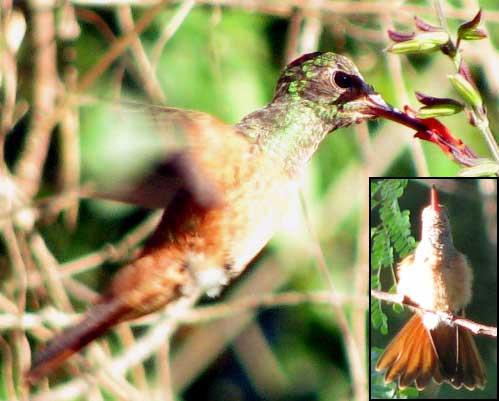Excerpts from Jim Conrad's
Naturalist Newsletter
from the November 21, 2010 Newsletter issued from Hacienda Chichen Resort beside Chichén Itzá Ruins, central Yucatán, MÉXICO; limestone bedrock, elevation ~39m (~128ft), ~N20.676°, ~W88.569°
HUMMINGBIRD PUZZLE
The roadrunner was easy to identify, but it was hard to figure out who was the rufous-bottomed, madly zipping hummingbird who's been visiting the Wild Scarlet Sages next to the garden for the last week or so. You can see what that bird looked like below:

This is an immature bird, as attested by the fact that none of the adults illustrated in field guides match it, plus the green on the head is speckled, which often is the case with immatures acquiring their adult plumage. Still, three important field marks give the identity away:
Of the six or seven hummingbird species expected in this part of the Yucatan, two species have those features -- the Rufous-tailed and the Buff-bellied Hummingbirds. Actually, we're a bit north of the Rufous-tailed's distribution area, but with forest destruction and global warming stirring things up I wouldn't be surprised to find the species here.
The inset at the lower, right cues me that we have a Buff-bellied because that species' tail is forked just as the picture shows. The Rufous-tailed's isn't nearly as deeply incised.
So, Buff-bellied Hummingbird, AMAZILIA YUCATANENSIS. With yucatanensis in the binomial you might expect this species to be endemic to the Yucatán, but actually it's distributed from the southernmost tip of Texas along Mexico's Gulf Coast, then all through the Yucatán, northernmost Guatemala and northern Belize.
Its habitat is described as "arid to semihumid forest and edges, brushy scrub, clearings with flowers," which is exactly what we have here.